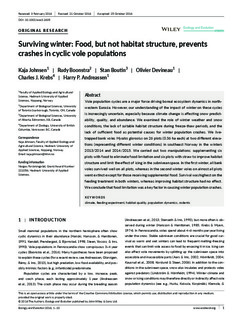Surviving winter: Food, but not habitat structure, prevents crashes in cyclic vole populations
Johnsen, Kaja; Boonstra, Rudy; Boutin, Stan; Devineau, Olivier; Krebs, Charles J.; Andreassen, Harry Peter
Journal article, Peer reviewed
Permanent lenke
http://hdl.handle.net/11250/2425473Utgivelsesdato
2016Metadata
Vis full innførselSamlinger
Originalversjon
10.1002/ece3.2635Sammendrag
Vole
population
cycles
are a major
force
driving
boreal
ecosystem
dynamics
in north
-
western
Eurasia.
However,
our understanding
of the impact
of winter
on these
cycles
is increasingly
uncertain,
especially
because
climate
change
is affecting
snow
predict
-
ability,
quality,
and
abundance.
We
examined
the role
of winter
weather
and
snow
conditions,
the lack
of suitable
habitat
structure
during
freeze-
thaw
periods,
and
the
lack
of sufficient
food
as potential
causes
for winter
population
crashes.
We
live-
trapped
bank
voles
Myodes glareolus
on 26 plots
(0.36 ha
each)
at two
different
eleva
-
tions
(representing
different
winter
conditions)
in southeast
Norway
in the winters
2013/2014
and
2014/2015.
We
carried
out two
manipulations:
supplementing
six
plots
with
food
to eliminate
food
limitation
and six plots
with
straw
to improve
habitat
structure
and limit
the effect
of icing
in the subnivean
space.
In the first
winter,
all bank
voles
survived
well
on all plots,
whereas
in the second
winter
voles
on almost
all plots
went
extinct
except
for those
receiving
supplemental
food.
Survival
was
highest
on the
feeding
treatment
in both
winters,
whereas
improving
habitat
structure
had no effect.
We conclude
that
food
limitation
was a key factor
in causing
winter
population
crashes.
